On 21 January 2010, there were still 198 prisoners at Guantánamo Bay, the date by which Barack Obama was supposed to have closed the detention facility. The 2008 election promise of a “change you can believe in” never materialised. With respect to Guantánamo, Obama’s presidency can be best described as one of slick speeches coupled with inaction, and only a string of broken promises to his credit.

The use and defence of torture and other illegal practices have continued, as have military commissions, after a brief moratorium during which the system was revamped but not improved. The rhetoric on Guantánamo did not change from the Bush to Obama era. It did not have to: the mainstream media ensured the issue fell off the radar altogether.
The main challenge for the London Guantánamo Campaign (LGC) throughout Barack Obama’s presidency has been keeping the issue alive: many people believe Barack Obama actually closed Guantánamo by 2010. Our activists are often asked why they are still protesting.
We have risen to the challenge with creativity. The LGC remains one of the main and most active campaigning organisations about Guantánamo in the world, responding quickly to events and displaying a willingness to stand up for the rights of prisoners released from Guantánamo still suffering the effects of the related stigma.
Ch-ch-changes
British residents: Although the LGC continued to hold some meetings and activities for Shaker Aamer until 2010, that campaign was capably taken over by the south London-based Save Shaker Aamer Campaign (SSAC) set up in 2009. The LGC worked closely with the tireless SSAC and took part in the many parliamentary meetings and demonstrations organised.
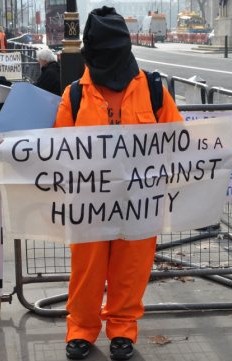
The only remaining British resident the LGC continued to campaign for was Algerian Ahmed Belbacha, who returned to Algeria in September 2014. All work on his case – mainly letter-writing campaigns – was carried out with the instruction of his lawyers at Reprieve and in conjunction with local Amnesty groups working on his case.
Con-Demed: 2010 saw major political change in the UK with the election of the right-wing Conservative-Liberal Democrat coalition government, followed by the current Conservative government in 2015. Under the Conservatives, an effective opposition in parliament has been annihilated, and human rights have become a dirty word. Assuming her position as the most senior female politician in the Coalition government in 2010, former Liberal Democrat MP Sarah Teather ended the APPG on Guantánamo, as it no longer served a purpose.
Omerta: The Binyam Mohamed torture judgment in February 2010 dealt a huge blow to the credibility of the intelligence services, from which it has yet to recover. Then head of MI5 Jonathan Evans took the unprecedented step of immediately denying torture collusion in the press. The aftermath of the case saw many other cases emerge of British intelligence and military complicity in torture and other crimes against humanity involving British and foreign nationals, leading to a raft of litigation.
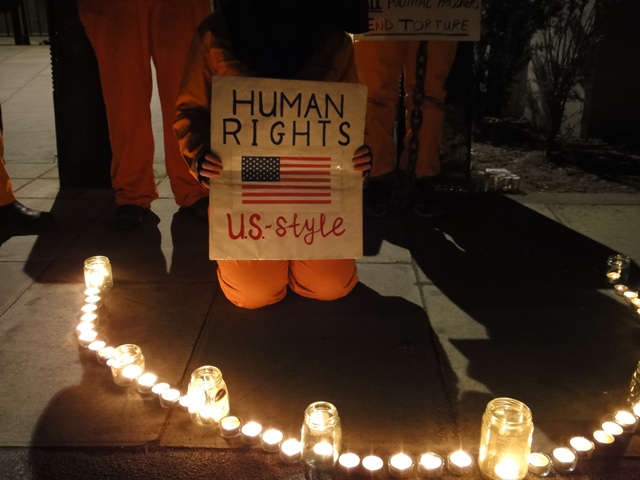
In response to continued claims by the Labour government that such disclosure had endangered national security, in a letter published in the London Evening Standard newspaper on 15 February 2010, the LGC stated “Now the Government claims that it is the victim of “ludicrous lies” and offers blanket denials in the face of detailed evidence pointing to complicity; the head of MI5 warns of “campaigns to undermine our ability to confront [our enemies]”, as if this matter fell into that category. When the Government and intelligence services resort to such drastic overstatement and scaremongering to keep scrutiny at bay, the public has a democratic right to know why.” The Conservative government maintains the same position on all such claims to date.
Brick wall: Further afield, the Arab Spring and the situation in the Middle East made it difficult for many prisoners to go home to war torn or unstable countries. In 2010, Barack Obama’s moratorium on returns to Yemen sealed the fact that he would not close Guantánamo in his first term.
All of these changes meant that the LGC’s focus became broader, demanding the release of all prisoners at Guantánamo, Bagram and other similar US-run facilities, and demanding accountability from the British government for its collusion in crimes against humanity.
2010:
Eighth anniversary: Amnesty UK and Cageprisoners held two events to highlight Shaker Aamer’s case: a letter delivery delegation to Downing Street and a meeting in parliament with his US lawyer Brent Mickum. At this stage, Shaker Aamer was not represented by Reprieve. In between, the LGC held a lunchtime demonstration outside the US Embassy, attended by several dozen people and addressed by speakers including Jean Lambert MEP.
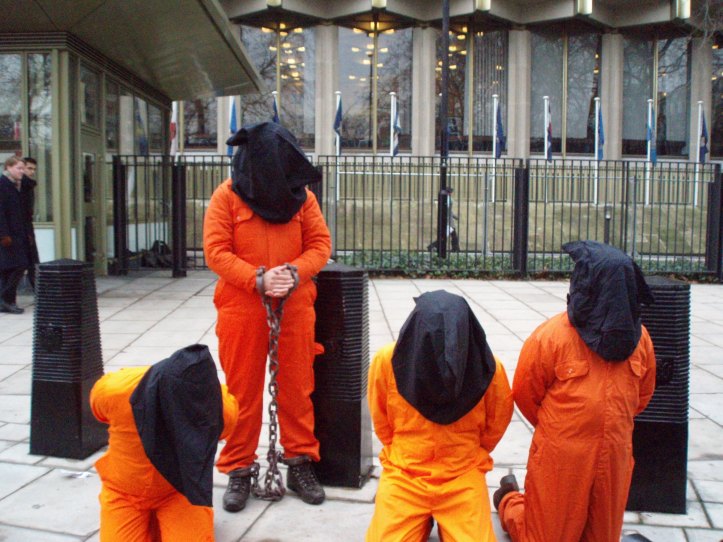
All of the day’s events received minimal media attention. Guantánamo had become a non-issue. In a New York Times editorial in June, it was reported that closing Guantánamo Bay was no longer a priority for the Obama administration and it was unlikely that it would close before the end of his first term in 2013.
International Day in Support of Victims of Torture: By May, Foreign Secretary William Hague had called for an inquiry into British complicity in CIA torture. The broad strokes of this – the Gibson Inquiry which collapsed under the weight of criminal investigations and the boycott by victims and NGOs – and draft legislation to restrict future cases such as that by Binyam Mohamed were presented by David Cameron in parliament in July. In November, the government reached a secret out-of-court settlement with the former British prisoners who sued the government for information it knew about their ordeals while held by the US.
Amid such claims of prisoner abuse, torture and even murder, in Iraq, the LGC was dismayed to discover that 26 June – United Nations International Day in Support of Victims of Torture – coincided that year with Armed Forces Day, marked in the UK since 2006 on the last Saturday in June. As a result, the LGC has since organised a public rally in solidarity with all victims of torture around the world on that date. Along with the Guantánamo anniversary action in January, these are the two main events organised by the LGC each year. It is one of the few events held in the UK to mark this date.
The focus of this first solidarity action was the CIA’s kidnap and torture outsourcing programme: extraordinary rendition. Around 70 people joined this first event, and speakers made contributions from prisoner solidarity and anti-war organisations, as well as Sarah Ludford MEP.
Omar Khadr: With the reinstatement of military commissions, the first trial under Obama set an international law precedent when Canadian Omar Khadr, accused of killing a US military officer aged 15, became the first person since World War II to stand trial, in a case marked by evidence obtained through torture, as an adult for war crimes allegedly committed as a minor.
In January, the Canadian Supreme Court held the Canadian government had violated his constitutional rights by failing to protect his human rights. In light of this, and the 2012 Winter Olympics in Canada, the LGC launched a letter-writing campaign demanding the Canadian government repatriate Khadr. It would eventually be the Canadian government of Stephen Harper that delayed Khadr’s release from Guantánamo.
The trial was set to be held in August; the LGC held a protest outside the US Embassy in solidarity. However, his lawyer collapsed at trial, and the case was set back to October, when in a secret plea bargain Khadr pleaded guilty in return for a reduced sentence. He is currently appealing from Canada where he has been released on bail.
2011:
Ninth anniversary: With the lack of media interest in Guantánamo, the LGC realised it was necessary to find other ways of capturing the public’s imagination and raising awareness. Demonstrations and protest actions have thus become increasingly artistic and creative, promoting a simple message in an eye-catching manner. The relatively small size of Guantánamo protests has allowed better engagement with the public who, although often uninformed, are sympathetic to the need for justice.
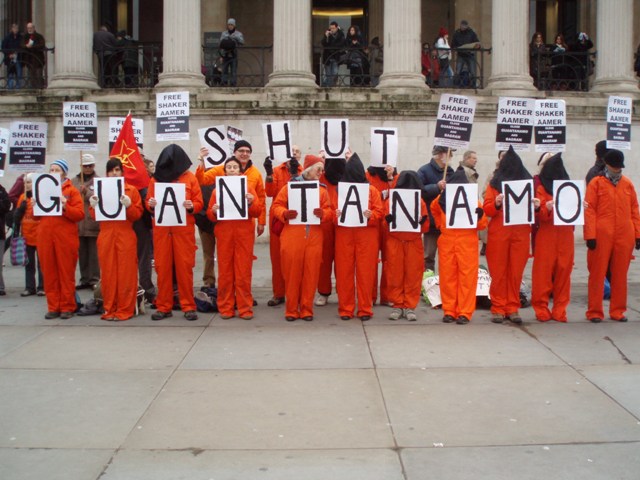
The LGC marked this anniversary with a “Gone Beyond Words” action. With Peace Strike, the LGC delivered a letter to Downing Street signed by 75 organisations, politicians and individuals demanding that the British government step up its action to help close Guantánamo and demand the immediate release and return to the UK of Shaker Aamer.

At lunchtime, around 70 people, some who had travelled to London especially, helped to create a special art installation outside the National Gallery in Trafalgar Square: a bright and colourful display with the simple message of “Shut Guantánamo”.
Prisoner support: Over the year, the LGC combined its monthly demonstration outside the US Embassy with other prisoner support campaigns. Joint protests were held with British campaigns for Babar Ahmed and Talha Ahsan who were extradited to the US in November 2012, Mumia Abu Jamal, and Chelsea Manning. 2011 also saw a mass hunger strike at the Pelican Bay ‘Supermax’ prison in California, against solitary confinement, a practice also used at Guantánamo. The LGC also took action in support with these prisoners. On 4 July, the LGC held a special solidarity protest with US political prisoners, attended by various campaigns.
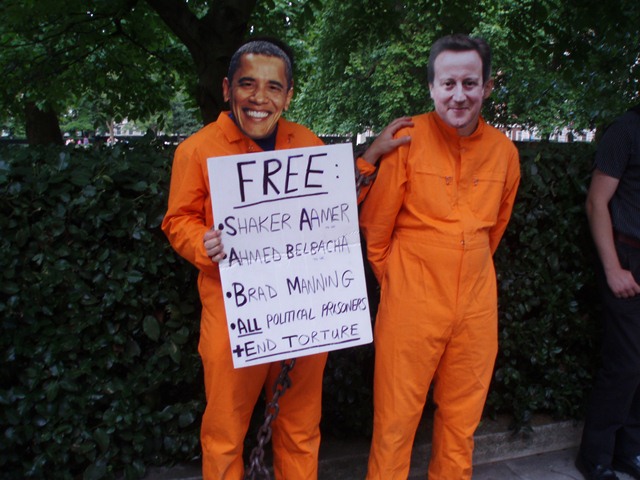
Presidential visit: In May, Barack Obama visited the UK. The LGC took part in a number of protests organised at the time by other groups, such as the SSAC. Two letters, one of which was signed by a number of leading lawyers and activists, were not published by the press, and instead were placed on the LGC’s website.
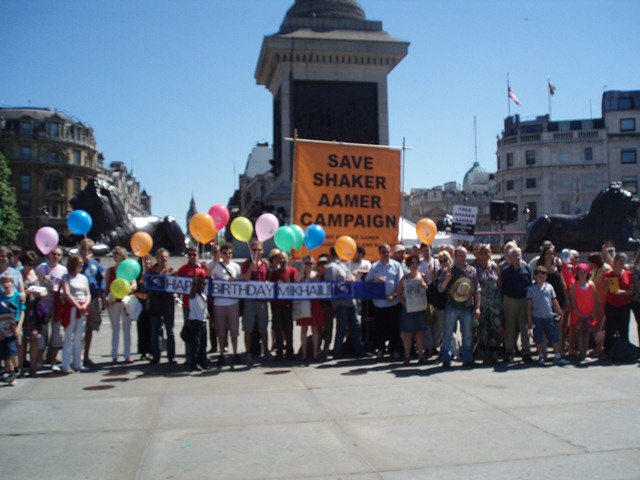
Solidarity! The LGC marked International Day in Support of Victims of Torture with a joint vigil in Trafalgar Square with Kingston Peace Council. Speakers at this event included Jean Lambert MEP, Amnesty International, Dr Frank Arnold, campaigners against the torture of Sikh prisoners in India, and supporters of Russian political prisoner Mikhail Khodorkovsky (released 2013), whose birthday falls on the same date.
2012:
Tenth anniversary: Another year, another Guantánamo anniversary: having notched up 10 years of existence, this anniversary received more media attention. The LGC marked it with a joint protest with the SSAC, the Stop The War Coalition (STWC) and the Campaign Against Nuclear Disarmament (CND) in Trafalgar Square the previous Saturday, 7 January. This action, entitled “End 10 Years of Shame”, was attended by hundreds of people from across the UK and included talks by London MEPs Sarah Ludford and Jean Lambert, lawyer Louise Christian, and speakers from various NGOs and campaigns.
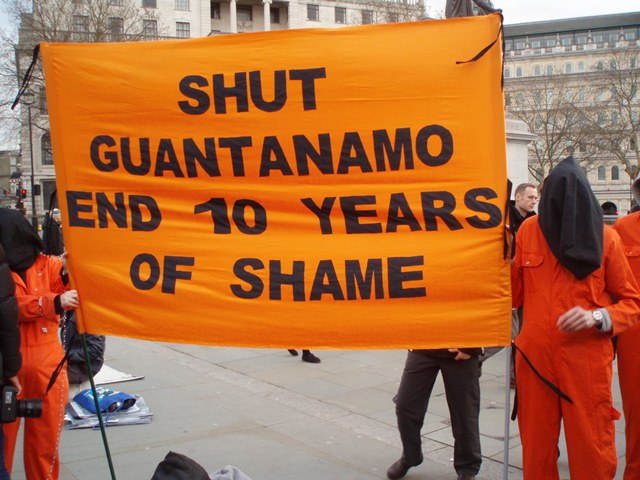
The talks were interposed with a catwalk action with volunteers in orange jumpsuits and black hoods parading past with placards bearing prisoner numbers as the names of the remaining prisoners these numbers refer to were read out. This visual display was very well received by demonstrators and passers-by.
On the 11th January, the LGC delivered a petition to the US Embassy, signed by over 400 people, demanding the closure of Guantánamo Bay and the release and return to the UK of prisoners Shaker Aamer and Ahmed Belbacha.
The revived media interest in Guantánamo was short lived. Nonetheless, alongside the regular monthly demonstrations to raise awareness outside the US Embassy, the LGC also held further actions for Omar Khadr when Canada failed to repatriate him once he had completed his sentence at Guantánamo (he returned to Canada in September 2012), as well as two other demonstrations:
No to Torture! The 2012 Olympics were held in London. The LGC got into the spirit of things and the celebration of this multicultural and vibrant city with a multilingual “No to Torture” action in Trafalgar Square, also marking the twenty fifth anniversary of the United Nations Convention Against Torture, which became international law on 26 June 1987. Placards were held up with this simple message in over 30 languages, including Arabic, Persian, Indonesian, Swahili, Finnish, Greek, Russian, Hebrew and others. Joined by other anti-torture campaigners, the action was a hit with tourists and passers-by, who engaged with its simple message and stopped to check if their own language was included and to see how many they could read and identify. The visually stunning action was featured on the cover of the global report of actions compiled annually by the International Rehabilitation Council for Torture Victims (IRCT) for 2012.
Act II: Having protested as Obama was being elected in 2008 and as he was inaugurated in 2009, the LGC also held a protest on the evening of the 2012 US presidential election, 6 November. With speakers from other prisoner campaigns and spoken word performances by some outstanding and talented young performers, over 50 people joined this protest. Guantánamo was not an election issue at all in this campaign.
2013: would be the year that Guantánamo would be firmly placed back on the map: not through the efforts of politicians or the media, but the prisoners themselves.
Eleventh anniversary: The LGC used this anniversary to shine a light on the complicity of states worldwide, through the facilitation of torture facilities and flights for the CIA. While to date no one has ever been prosecuted in the US for crimes against humanity related to Guantánamo, 2012 saw the only conviction of CIA agents for their complicity in the 2003 rendition to torture of an Egyptian imam in Milan, as well as the first of several positive judgments by the European Court of Human Rights holding European states liable for their complicity in CIA torture, in this case Macedonia’s complicity in the kidnap and torture of a German national.
For the first time, the LGC used social media extensively to communicate its day-long “All Roads Lead to Guantánamo” action live, tracing the routes via the embassies involved of four prisoners to Guantánamo, while in the evening, the groups converged outside the US Embassy for a demonstration. The prisoners whose stories were related included British residents Shaker Aamer and Ahmed Belbacha, Omar Khadr, and Abd Al-Nashiri, who was kidnapped in the UAE in 2002, held at secret prisons in three continents and tortured before being taken to Guantánamo in 2006 where he is currently facing trial.
The groups each visited at least four different embassies of countries prisoners passed through on their journeys to Guantánamo. Almost all the groups visited the Turkish and Portuguese Embassies, and were met with hostility by officials outside the former. Some groups delivered letters to embassies. More than 100 people followed their walking journeys across London online.
Over 70 people then converged and others joined a candlelight vigil outside the US Embassy where activists held up placards bearing statements Barack Obama had made about closing Guantánamo in the past.
The hunger games: The LGC continued to raise awareness about the plight of the Guantánamo prisoners. As part of the monthly demonstration in February, the LGC protested outside the Odeon cinema in Marble Arch about the release of torture film Zero Dark Thirty. This action was very well received and supported by the public.
By the end of that month, the LGC started to hear unconfirmed reports of a mass hunger strike at Guantánamo Bay. It would take the mainstream media almost two months to catch up and even longer to reveal that brutality, including the use of rubber bullets and dogs against prisoners, was part of the cause.
The hunger strike was confirmed by lawyers in early March, some of whom contacted the LGC to ask us to take action, given the never-ending stream of protest actions held in London. On 17 March, the LGC held the first protest action anywhere in the world in solidarity with the hunger striking prisoners outside the US Embassy. More than 30 people joined the action in the pouring rain on a Sunday afternoon, even though the hunger strike had not yet been mentioned by the US or UK media at all. Various anti-war and human rights campaigns and activists addressed the protest.
With the media still ignoring the hunger strike well into its third month in April, the LGC held a creative action to inform the public while poking fun at media inaction with “newspapers”, whereby small groups in orange jumpsuits and black hoods, or Obama masks, visited tourist destinations in London and sat down to read a newspaper cover we had put together informing the public of the hunger strike.
News about the hunger strike, involving almost all the 160 or so prisoners held at Guantánamo at the time, eventually started to trickle out that month due to the violent and bloody methods used by the US military to quell the protest by debilitated and frustrated prisoners who have never known why they are being held.
The LGC continued to protest, holding a further demonstration on 13 April outside the US Embassy. We were joined at this action by US activist Medea Benjamin from Code Pink. By the end of the month the hunger strike could no longer be ignored and on 30 April, the media questioned Barack Obama for the first time since 2010 about Guantánamo Bay.
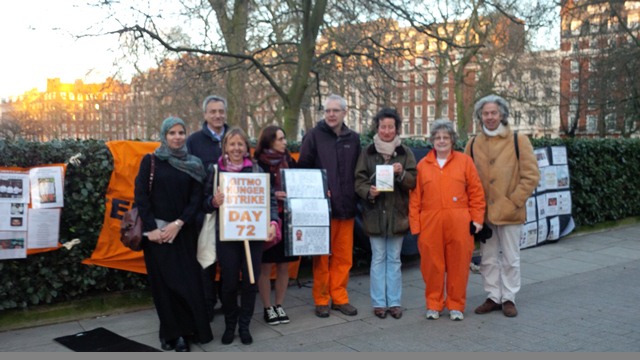
International weekend of action: Following Medea Benjamin’s visit, in coordination with other campaign groups in the US and worldwide, the LGC organised its biggest ever action by taking the lead in organising an international weekend of solidarity action on 17-19 May to mark the one hundredth day of the hunger strike on 17 May. Demonstrations were held in the US, Mexico, Australia, and Spain. Many also took part in solidarity fasts worldwide. A special video was put together to mark the date:
Anonymous took part in the action by organising successful Twitter storms for three successive days to raise awareness. In the process, Anonymous was accused of hacking into and shutting down military computer systems at Guantánamo Bay on 18 May, when in reality internet and Wi-Fi access had been disconnected by the military to prevent soldiers learning of the solidarity actions taking place worldwide. The global response was enormous, showing a general popular consensus worldwide in support of the Guantánamo prisoners and their hunger strike.
With over 14 actions organised in England, Scotland and Wales over that weekend, the response in the UK was phenomenal. From solo protests and fasts, to demonstrations in sleepy English villages, the British public demonstrated true British values by showing their solidarity against this injustice, even though at this stage the issue was still broadly ignored in the British press. In Lewes, MP Norman Baker was the only politician to join the action. One activist took her orange jumpsuit protest all the way from Bradford to the football second league play-offs at Wembley Stadium in London. Fellow Bradford City supporters showed their support.
In London, over 80 people joined the “Starving for Justice” protest organised by the LGC, which included a crime scene and die-in outside the US Embassy. A mock force-feeding scene was also staged briefly. A number of grassroots organisations helped to put the demonstration together.
The hunger strike has yet to end; the US military simply stopped providing data in relation to it at the end of 2013. It was also highlighted at the 26 June protest to mark torture day: the UN and human rights experts deemed the force feeding of hunger striking prisoners by nasal tube to constitute torture. On that occasion, the LGC also teamed up with the creative folks at All Riot to produce special t-shirts for the event.
In 2013, another mass prisoner hunger strike broke out across California in solidarity with prisoners held in solitary confinement, sometimes for decades on end, at the Pelican Bay Supermax prison.Much of the abuse at Guantánamo Bay also occurs frequently in US federal prisons too.
In June that year, the LGC held its first solidarity demonstration with US-Palestinian prisoner Shawki Ahmed Omar who has been held without due process in Iraq since 2004. He was tortured at Abu Ghraib. Omar’s wife and daughter who live in the UK have joined and spoken at LGC events on a number of occasions.
2014:
Twelfth anniversary: The LGC marked this anniversary with its biggest ever demonstration. More than 250 people from across the UK joined the LGC outside the National Gallery in Trafalgar Square. The demonstration started with a visual display creating a wall of colourful banners pointing out that Guantánamo Bay had now been open for 12 years. There were speakers from the Labour Party (Jeremy Corbyn MP), the Liberal Democrats (Sarah Ludford MEP) and the Green Party (Tony Clarke) as well as messages of support read out on behalf of other politicians. Other speakers included lawyer Louise Christian, representatives from NGOs and other grassroots groups working on Guantánamo.
This demonstration coincided with another one being held in Tottenham in support of Mark Duggan who was shot dead by the police in 2011, which led to riots across the country. Two mainstream television channels informed the LGC that they would be attending that demonstration instead in the hope that “it might kick off”. That did not happen.
Omar Khadr speaking tour: Having been released to Canada in 2012, the campaign for Omar Khadr was still warming up in Canada, and a raft of litigation was underway to secure his rights and freedom. Along with Free Omar Khadr Now (FOKN), the main campaign for Omar Khadr run from the Netherlands, the LGC brought Khadr’s Canadian lawyer Dennis Edney QC to the UK for an awareness raising tour about his client’s case.
Little known outside of Canada at the time, and still in jail, the LGC organised an impressive 10-day speaking tour covering London and York, taking in talks to students and academics at a number of universities, Amnesty International, the Haldane Society of Socialist Lawyers, Veterans for Peace UK and a local Amnesty group. The tour was well received, raised a lot of awareness about Omar Khadr’s case and demonstrated the breadth of organisations and individuals the LGC works with.
As well as raising awareness, funds had to be raised to accommodate Mr Edney and bring him to the UK. As well as a grant from the Lush Charity Pot, a crowd-funding initiative was carried out by Mahfuja Ahmed. The LGC holds few public meetings and prefers to take the message out to the unconverted on the streets.
Global Day of Action: On 23 May 2013 Barack Obama responded to the Guantánamo hunger strike with a string of promises that were largely not kept in a national security speech. To remind him of this latest promise, activists in the US organised a global day of protest on the anniversary. More than 45 protests took place across the world in 7 countries: Australia, Canada, Poland, Mexico, Germany, the US and the UK.
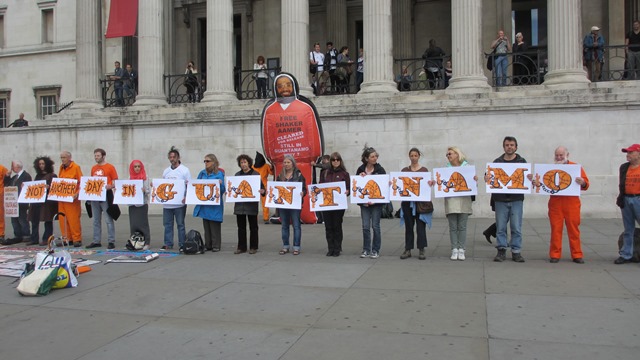
In London, over 50 people joined a silent lunchtime protest in Trafalgar Square in which protesters held up letters and words to spell out “not another day in Guantánamo”. The LGC also had a letter published to coincide in The Guardian newspaper, which stated: “Although he has released 11 prisoners, the slow progress after so many years shows there is no real intention of ending what can be considered a mass hostage crisis. For the 154 remaining prisoners, held almost wholly without charge or trial, rhetoric is not good enough.”
Impunity: With the theme of Torture Day focusing on fighting impunity, the LGC held a “See No Evil, Speak No Evil” silent vigil in Trafalgar Square. Around 50 people joined as the LGC focused on the war crimes and torture impunity of the British intelligence and military, as well as its collusion in CIA torture.
Impunity for torture would emerge as a major theme at the end of 2014 with the redacted publication of the executive summary of the US Senate Intelligence Committee into CIA Torture. This theme was picked up on in the action the LGC was already planning to mark the thirteenth anniversary of Guantánamo.
2015:
Thirteenth anniversary: The LGC successfully adopted a different approach to its anniversary action. Orange jumpsuits and placards were replaced with Covent Garden-style street theatre. Barack Obama’s rhetoric over the years, from 2007, was reframed into a street theatre performance outside the US Embassy: “The Three Obamas”. Placards were replaced by sandwich boards.
The three “missing years” of 2010 to 2013, during which Obama did not talk about Guantánamo and was not asked about it by the media, allowed an intermission for speeches. The event was livestreamed by Occupy London and the Islam Channel. More than 150 people joined the action. In recent years, the numbers of people joining the UK protest has matched numbers protesting outside the White House in Washington DC.
Right to rehabilitation: As well as the theme of Torture Day, this issue has increasingly become an important part of the LGC’s work as more information about the torture suffered by prisoners emerges and it becomes increasingly clear that freedom from Guantánamo creates a new set of problems and difficulties. The longer prisoners spend at Guantánamo the more acute their physical and mental health needs are.
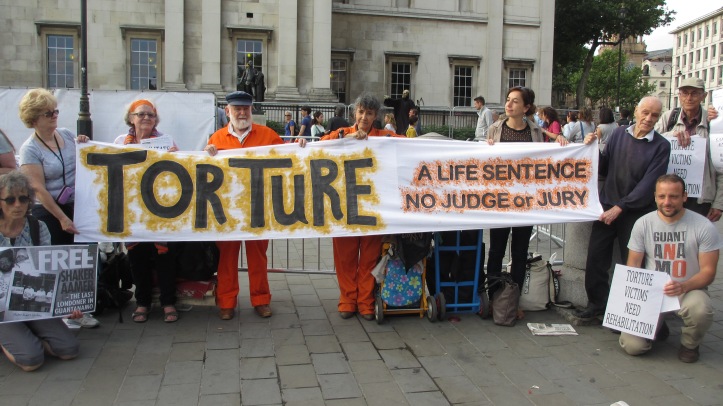
The LGC raised awareness of this issue at various events, including International Day in Support of Victims of Torture in June. In December, the LGC highlighted this further with an event to mark the first anniversary of the redacted and partial publication of the US Senate Intelligence Committee’s report into the CIA’s use of torture. Focusing on British complicity, torture as a practice rather than an abstract policy, specifically the medical and military aspects and ramifications of the use of torture, the LGC held a panel discussion with the Centre for Cultural Studies at Goldsmiths, University of London, on 8 December. Head of Doctors at Freedom from Torture Dr Juliet Cohen and Veterans for Peace UK coordinator Ben Griffin provided excellent expert contributions on the issue.
Shaker Aamer: Over 2014 and 2015, a number of new campaigns and actions sprung up for Shaker Aamer, the last British resident held at Guantánamo. The LGC continued to work closely with the SSAC, who campaigned tirelessly. Just a few days before his release, the SSAC organised a final protest outside Downing Street to mark the expiry of the one month period during which he should have been released after having been cleared by multiple US government agencies.
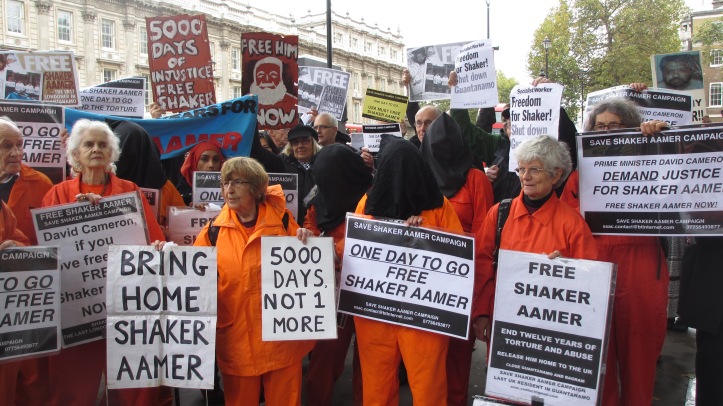
Shaker Aamer’s return to the UK was a joyful occasion for everyone who had campaigned for his release, and for his family. For the LGC, after almost a decade of campaigning, the first of three main campaign goals was finally achieved.
2016:
Fourteenth anniversary: As Barack Obama continued to repeat his mantra that he will close Guantánamo, the fourteenth anniversary of the facility crept up, with just over one hundred prisoners there on the anniversary date.
The LGC marked this sombre anniversary with a candlelight vigil outside the US Embassy entitled “History in the Making”, given that this was the last opportunity for activists to protest the anniversary and make a difference during the presidency of Barack Obama. More than 100 people joined this protest, even though the anniversary received no mainstream media mention in the UK.
The action included a number of former Guantánamo prisoners, including Shaker Aamer, who gave his first unmediated and public speech, sharing his powerful and poignant views on Guantánamo:
Man without a Plan:
The London Guantánamo Campaign was never intended to be around for so long; Guantánamo and all that it represents should have ended long ago. Since July 2015, Barack Obama insisted he had a plan to close Guantánamo before the end of his presidency. When the plan did not materialise, in September that year, the LGC launched an ongoing weekly Twitter awareness-raising campaign about Guantánamo using the hashtag #GitmObama. The ‘plan’, finally unveiled on 23 February 2016, was more about salvaging the outgoing president’s legacy on this issue, and while it may see the physical facility at Guantánamo close, it will merely transfer its defining feature of indefinite arbitrary detention elsewhere.

Indefinitely: Guantánamo should not be palatable. The truth has its own narrative and continues to drip like a leaking tap. Although this makes it impossible to see the comprehensive picture, for those who pay attention it comes increasingly into focus.
In a world fraught with so many problems, it may appear futile to focus on an issue that appears to affect a relatively small number of people. Guantánamo is more than a place and a set of endorsed illegal practices: it has become a way of life.
Practices synonymous with Guantánamo are also rampant in US federal prisons, and indefinite detention, especially for immigration detainees, is growing worldwide. The use of torture, particularly where terrorism can be used as an excuse, is increasingly accepted. Surveillance, control, and the illegal usurpation of power by those in charge with impunity, are now facts of life. For those who have survived Guantánamo, the nightmare does not end. It is a life sentence without judge or jury. Guantánamo and extraordinary rendition remain potent threats to the safety and liberty of everyone.
The secrecy surrounding the issue protects the military, governments and powers that be worldwide. The media and large NGOs have failed to attract attention to what it is governments are so eager to hide from their own citizens. Moreover, Guantánamo is usually seen as a US problem, even though none of the men held there are US citizens. The fact that such a vibrant campaign then exists in the UK bears testimony of the goodwill demonstrated by the British public in standing up against injustice wherever that may be. It is the people who have withstood wet, cold British winters, transport strikes, media misrepresentation and blatant government lies who are the true heroes of the ongoing campaign to close Guantánamo.
The photographs were taken by Richard Keith Wolff, activists and the author. The London Guantánamo Campaign holds the copyright to all the images.



























![image[2] image[2]](https://onesmallwindow.files.wordpress.com/2016/03/image2.jpeg?w=237&resize=237%2C237&h=237#038;h=237&crop=1)



























Excellent article!
thanks for being a part of the effort!
What a powerful statement of the excellent and tireless work you’ve done for a better world in the Obama years.